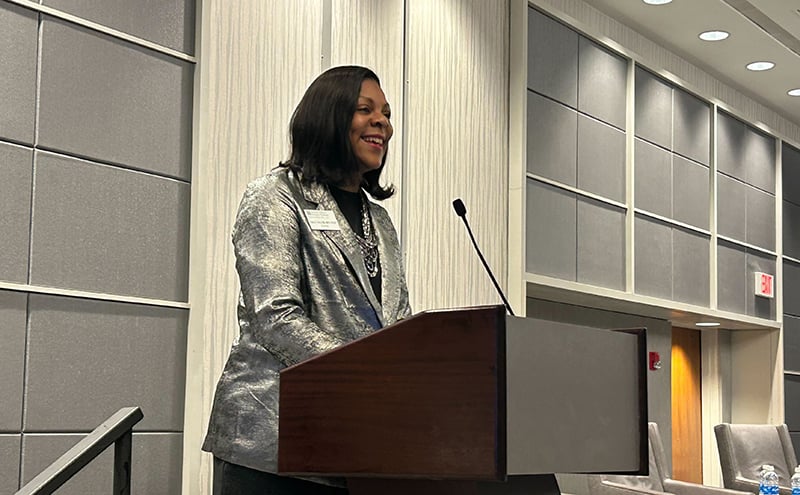Today’s online article covers some highlights from Monday, April 15, at the 2024 ACEP Leadership & Advocacy Conference, including many of the sessions on the hottest issues in emergency medicine. Check this link each day of the conference in real time for more updates.
Read more -
4:00 PM
In 2023, Indiana’s emergency physicians helped pass state legislation requiring an emergency physician to be present in every emergency department. It was intentionally brief – just one simple line – crafted to maximize its potential for success in their effort to prevent “scope creep” in their state.
During a panel on “ACEP's Model Legislation to Fight Scope Creep/Expansion,” Daniel W. Elliott, MD, FACEP, past president of ACEP’s Indiana Chapter, said they painted a picture for their state’s legislature: What if the lawmakers were driving down the highway, in a rural area, thought they were having a heart attack and saw the sign for a hospital, who would they expect to be there to treat them?
“I think that resonated more than the length of time and costs and all of the other things,” he said. “What really swayed legislators was that it was a patient expectation.”
Indiana’s legislative victory gave hope to other states facing similar challenges with nurse practitioners trying to gain independent practice.
In Virginia, Todd Parker, MD, FACEP, coupled parts of Indiana’s law with the chapter’s local knowledge of the state legislature, their specific circumstances, and past efforts. They found a unique way to combat the same issue of scope creep, by not addressing it by name.
“We did not say it was about scope at all. We made it about fixing outdated legislation,” Dr. Parker said.
Kim Horvath, JD, a senior attorney with the AMA Advocacy Resource Center, said the AMA has a lot of resources to help states who are actively fighting legislation or working to introduce bills to prevent NP or PA independent practice.
One powerful tool all of the ACEP leaders said they used in their efforts, were data and maps about staffing in specific areas.
“Even though they say they will go into rural areas (after gaining independent practice), this shows they do not,” she said.
The AMA can also work with ACEP’s state chapters on public relations campaigns, which can be very influential.
“it’s not just about the legislation, or you being right or wrong, or about facts,” Dr. Parker said. “Often there is no logic whatsoever in legislation. A lot of it is in the PR battle, too.”
Dr. Elliott said in Indiana, they were also successful by using workforce projections to illustrate that there is not likely to be a physician shortage, and that thinking that NP or PA replacements are more cost effective is short sighted.
“Just because salaries are cheaper, it doesn’t mean the overall health care is,” Dr. Elliott said.
All the panelists emphasized that each state is different, and while ACEP’s model legislation is a good starting point, each approach should be different and tactics will need to be tailored.
“We are fighting battles at the state levels that are a nationally coordinated, state-executed plan,” Dr. Parker said.
10:45 AM
ACEP is leading hard conversations about the boarding crisis. People are listening but “they need to understand that this is not an ED problem, it is systemic,” said Karin Rhodes, MD, MS, Chief Implementation Officer for the Agency for Healthcare Research and Quality (AHRQ). “I hope everyone here continues to raise their voice.”
During a session at LAC titled “All Aboarding! Advocating for Change,” panelists echoed concerns shared by ACEP and emphasized that work with regulatory agencies doesn’t have to be viewed as restrictive, but it can be enabling.
That’s the case with the recent development of ACEP-supported metrics, for example, which would be applied to encourage accountability with an eye toward best practices for older patients.
Emergency physicians know that boarding is a complex problem with no single solution. But data has the power to change the conversation, according to Helene Anderson, vice president of capacity and outreach at Apprise.
Apprise is an ACEP collaborator and creator of statewide and regional dashboards in Oregon and other states.
“Boarding is a problem that requires solutions across the continuum of care,” Ms. Anderson said.
When ACEP puts the influence of its members in motion, the government listens. The reality is that progress is being made but emergency physicians simply cannot solve this crisis alone.
ACEP convened the first national stakeholder stakeholder summit on boarding in October 2023. Dr. Rhodes explained that AHRQ participation in the ACEP summit “gave the agency ideas on how to move forward that are being implemented today.”
ACEP initiatives, like the summit, have the power to make a meaningful difference. As panel moderator C. Ryan Keay, MD, FACEP, said, “Don’t take the pressure off.”
10:00 AM
In what would be an unprecedented event, a Michigan emergency physician union is scheduled to go on strike on Thursday if good-faith negotiations between the physicians, their employer group and the hospital don’t come to resolution in the coming days.
The panel discussion on Monday at the 2024 ACEP Leadership & Advocacy Conference, “In Order to Form a More Perfect Union…ization?” offered a very timely discussion.
“I call it the Bermuda Triangle. These employees are caught between the negotiations of their employer and the hospital,” said panelist, Diana Nordlund, DO, JD, FACEP.
Panelist Sean Codier, DO, has first-hand experience with a physician union. He works at Salem Hospital in Massachusetts, where last month, several emergency physicians voted to form the Salem Hospital Physicians Union.
“Our ultimate goal is to reinsert physicians into the process,” he said. “We wanted to reinsert ourselves into how care is decided. That’s the primary motivator for why most joined our union.”
He said their efforts will include, in part, work on negotiating their own contracts, deciding how to staff, and how the emergency department is resourced.
The emergency physicians at the hospital exhausted a number of attempts to improve their practice environment, Codier said, and they were “out of options” before considering joining a union.
Bing S. Pao, MD, FACEP, also a panelist, noted that physician-owned groups (like his employer Vituity) do offer their physicians access to payment transparency as well as other decision-making abilities within the group.
“I see unionization as one solution but not the solution for everyone,” Dr Pao said, adding that there are global issues in emergency medicine “that we need to address holistically with a number of solutions.”
“It is yet to be determined how well (physician unions) will improve the environment,” he added.
Dr. Nordlund also pointed out that not all physicians interested in joining a union would be able to do so legally.
“Employee status is required to be part of a union and then there is a nice range of gray situations,” she said, explaining that those who are independent contractors or receive 1099s may or may not be eligible.
Supervisors usually are not allowed to join a union, Dr. Nordlund said, but the legal definition would not necessarily mean overseeing other medical professionals, but more commonly an ED director or possibly an assistant director.
8:00 AM
With hundreds of emergency physicians from across the nation gathered in Washington, DC, the 2024 ACEP Leadership and Advocacy Conference got into full swing Monday with day full of sessions on the hottest issues facing emergency medicine.
ACEP President Aisha Terry, MD, MPH, FACEP, officially welcomed the attendees with a call to use the time for rejuvenation and to use our collective voices for the specialty.
“Our goal is to do what we do every day in our emergency departments, which is to get things done,” she said.





